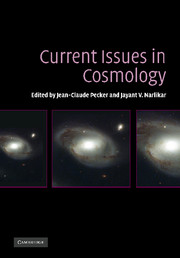Book contents
- Frontmatter
- Contents
- List of contributors
- Preface
- Part I Observational facts relating to discrete sources
- Part II Observational facts relating to background radiation
- 4 CMB observations and consequences
- 5 Abundances of light nuclei
- 6 Evidence for an accelerating Universe or lack of?
- Part III Standard cosmology
- Part IV Large-scale structure
- Part V Alternative cosmologies
- Part VI Evidence for anomalous redshifts
- Part VII Panel discussion
- Index
4 - CMB observations and consequences
Published online by Cambridge University Press: 15 December 2009
- Frontmatter
- Contents
- List of contributors
- Preface
- Part I Observational facts relating to discrete sources
- Part II Observational facts relating to background radiation
- 4 CMB observations and consequences
- 5 Abundances of light nuclei
- 6 Evidence for an accelerating Universe or lack of?
- Part III Standard cosmology
- Part IV Large-scale structure
- Part V Alternative cosmologies
- Part VI Evidence for anomalous redshifts
- Part VII Panel discussion
- Index
Summary
Abstract
I describe briefly the Cosmic Microwave Background (hereafter CMB) physics, which explains why high accuracy observations of its spatial structure are a unique observational tool to test our cosmological models, determine the global cosmological parameters, and constrain observationally the physics of the early Universe. I also briefly survey the many experiments that have measured the anisotropies of the CMB and led to crucial advances in observational cosmology. The somewhat frantic series of new results has culminated in the outcome of the WMAP satellite, which confirmed earlier results, set new standards of accuracy, and suggested that the Universe may have reionized earlier than anticipated. Many more CMB experiments are currently taking data or being planned, offering opportunities to challenge further the current concordance model. The large increase in accuracy promises the possibility of falsifying or consolidating even more strongly the current paradigm, which has already met with considerable predictive success.
Introduction
As we shall see, the analysis of the CMB temperature anisotropies indicates that the total energy density of the Universe is quite close to the so-called critical density, ρc, or equivalently Ω = ρ/ρc ≃ 1. We therefore live in a close-to-spatially-flat Universe. In agreement with the indications of other cosmological probes, the team of the CMB satellite WMAP [4] found that about 30% of that density appears to be contributed by matter (ΩM = 0.29 ± 0.07), most of which is dark – i.e., not interacting electromagnetically – and cold – i.e., its primordial velocity dispersion can be neglected.
- Type
- Chapter
- Information
- Current Issues in Cosmology , pp. 49 - 68Publisher: Cambridge University PressPrint publication year: 2006
- 1
- Cited by

